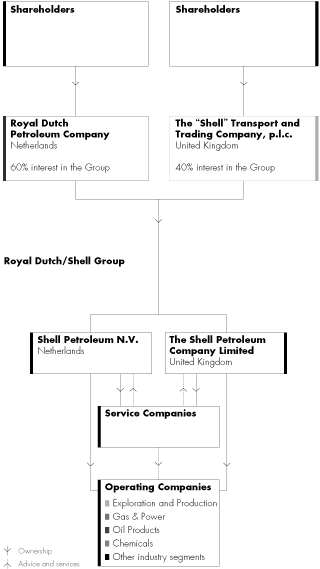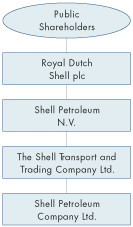After I explained the BHP vs BBL shares for BHP Billiton, I realized I may as well dive into the complexity of the Royal Dutch Shell Class A vs Class B shares. I had originally avoided it when writing about the shares I picked up for the KRIP the other day, but there seems to be an interest in this sort of minutia that I try to avoid because normally, I get passionate about it and people then look at me like I’m nuts. For those of you who like to understand the actual structure of things, today is your lucky day.
Royal Dutch Shell Used To Be Structured in a Similar Way to BHP Billiton
Back in 1907, the European oil powers grew nervous over John D. Rockefeller setting his sights on their shores. Two competitors decided to join forces and create a powerhouse that would rival Standard Oil and keep the titan on his side of the pond. The two companies were N.V. Koninklijke Nederlandsche Petroleum Maatschappij in The Netherlands, and Shell Transport and Trading Company Ltd in the United Kingdom.
[mainbodyad]The assets were combined, but the two parent companies remained distinct legal entities, traded on the stock exchanges of their respective countries, so you could buy into it whichever way was better for your family; the British liked Shell, which paid out dividends in Pound sterling, while the Dutch liked N.V. Koninklijke Nederlandsche Petroleum Maatschappij, which paid out its dividends in guilders, and later, Euros. It was a unique artifact of history that served its purpose well for a very long time. Whether your family owned the Dutch firm or the British firm, your share of the underlying assets remained the same, for all intents and purposes.
The old Royal Dutch Shell legal structure looked like this:
In 2005, as a result of an accounting scandal that was unthinkable given Shell was one of the most conservative businesses in the world and had compounded stockholder money by more than 14% with dividends reinvested for nearly a century – a feat few other businesses have ever achieved – a massive restructuring took place.
In 2005, Royal Dutch Shell Was Simplified Under One Parent Company with Two Classes of Stock
In this restructuring, the two companies, Shell in England and N.V. Koninklijke Nederlandsche Petroleum Maatschappij in The Netherlands, were delisted and merged under a new, parent company that was created to own the energy conglomerate. There was now only one business, called Royal Dutch Shell. It was registered in England and Wales, headquartered in The Netherlands
The “public shareholders” in the above chart were issued two classes of stock, both of which are identical in practically all meaningful ways, including equal economic and voting rights.
- Class A shares – These represented the old N.V. Koninklijke Nederlandsche Petroleum Maatschappij. They are subject to a 15% Dutch withholding tax on dividends unless you are a special exempt pension trust or a special type of exempt organization. If you ever managed to get your hands on 10% ownership of the business, which only a handful of people on the planet could come up with the tens of billions of dollars to do, your withholding rate would drop to 5%.
- Class B shares – These represented the old Shell Transport and Trading Company shares. They are subject to no (0%) withholding tax on dividends.

Royal Dutch Shell headquarters in The Netherlands. The company generated $467.2 billion in sales and earned $26.8 billion in income last year.
Image courtesy of P.L. van Till at nl.wikipedia under Creative Commons Attribution-Share Alike 3.0 Unported License
The Class A and Class B Shares Were Then Listed in Three Different Countries
To make the shares widely available to investors, Royal Dutch Shell then created 6 listings in 3 countries. With a few exceptions, which we will discuss later, the same rules apply – the Class A shares are subject to a 15% Dutch withholding tax on dividends, while the Class B shares are not.
The Netherlands
On the listings in The Netherlands, the stocks both trade in Euros. Dividends are paid by default in Euros on the Class A shares and Pound sterling on the Class B share, though you can elect for the other if you prefer.
- The Class A shares trade on the Amsterdam Stock Exchange under ticker symbol RDSA.
- The Class B shares trade on the Amsterdam Stock Exchange under ticker symbol RDSB.
Great Britain
On the listings in London, the stocks both trade in Pound sterling. Dividends are paid by default in Euros on the Class A shares and Pound sterling on the Class B share, though you can elect for the other if you prefer.
- The Class A shares trade on the London Stock Exchange under ticker symbol RDSA.
- The Class B shares trade on the London Stock Exchange under ticker symbol RDSB.
New York
To make it possible for investors in the United States to own shares in the company, Royal Dutch Shell worked with an investment bank, The Bank of New York Mellon, to create a special type of financial instrument. It deposited shares of the Class A and Class B stock with the bank, then issued receipts against these as proof that they were there (called American Depository Shares, or ADS). Those ADS were these packaged into new securities called American Depository Receipts (or ADR).
Each ADR represented 2 shares of the underlying Class A or Class B stock. Dividends are paid in United States dollars.
- The Class A ADR trade on the New York Stock Exchange under ticker symbol RDS.A.
- The Class B ADR trade on the New York Stock Exchange under ticker symbol RDS.B
This Presented a Choice of 6 Different Listings for an Investor Buying Stock in Royal Dutch Shell
To summarize again, all in one place, this means if you wanted to buy stock in Royal Dutch Shell, your options were:
- Class A shares in Amsterdam, quoted in Euros, dividends in Euros (but you can ask for Pound sterling, instead), 15% dividend withholding tax.
- Class B shares in Amsterdam, quoted in Euros, dividends in Pound sterling (but you can ask for Euros, instead), no dividend withholding tax.
- Class A shares in London, quoted in Pound sterling, dividends in Euros (but you can ask for Pound sterling, instead), 15% dividend withholding tax.
- Class B shares in London, quoted in Pound sterling, dividends in Pound sterling (but you can ask for Euros, instead), no dividend withholding tax.
- Class A ADR in New York, representing 2 shares of the Class A stock, quoted in U.S. dollars, dividends in U.S. dollars, 15% dividend withholding tax
- Class B ADR in New York, representing 2 shares of the Class B stock, quoted in in U.S. dollars, dividends in U.S. dollars, 0% dividend withholding tax
The Class B shares were subject to no withholding from the Dutch Government, while the Class A shares were unless you were exempt through some special loophole.
This effectively lets an investor in Royal Dutch Shell select whichever is most beneficial for him or her. You can receive Euros, Pound sterling, or U.S. dollars. You can have Dutch withholding taxes taken out of your dividends or not.
How the Royal Dutch Shell Class A and Class B Structure Matters To an American Investor Buying Through a Retirement Account
If you are an American investor, living in the United States, and holding your stock through a Traditional IRA, Roth IRA, SEP-IRA, SIMPLE IRA, pension plan, 401(k), 403(b), or other tax-shelter, the Class A stock puts you at a disadvantage in most circumstances because the Dutch government is going to take 15% of your dividends right off the top. This is a problem because the IRS in the United States will not let you claim those taxes you paid against your income since they are held in a tax shelter. That means you just lost the money. It’s gone forever.
That is why tend to prefer the Royal Dutch Shell Class B shares in any of my U.S. based retirement accounts I control. I get to enjoy all of the dividend income, and don’t have to pay any of it to any government. The fresh funds show up constantly throughout the year, unrestricted, sitting there, waiting for me to put them to work in other securities or investments.
There is a rare set of circumstances in which the Class A shares are better for American retirement accounts. We’ll talk about that unique situation later.
How the Royal Dutch Shell Class A and Class B Structure Matters To an American Investor Buying Through a Regular Brokerage Account
For investors in the United States, if you are buying Royal Dutch Shell through a regular, taxable brokerage account, it matters much less whether you select the Class A or Class B ADR. If you select the Class A ADR and pay the 15% Dutch withholding tax, you will probably be able to reclaim it when you file your own taxes with the IRS. To understand the specifics, you’d need to consult with a qualified adviser, as well as read IRS Publication 514 Foreign Tax Credit for Individuals (the link will take you to a PDF version for the 2012 rules; you will need to check future publications if reading this at a later time as the guidelines may change).
How the Royal Dutch Shell Scrip Dividend Program Works
If the Class A ADR look like a better deal at any given moment, you can get around the Dutch withholding tax by signing up for the Scrip dividend program. Basically, Royal Dutch Shell will agree not to send you any cash, and instead, deposit additional shares of the Class A ADR as a stock dividend into your account. This will exempt you from the 15% Dutch withholding tax. The bad news is, the IRS will still want its 15% dividend tax in April, which is unfortunate because most of the time, stock dividends are tax-deferred. The reason the Scrip dividends are taxes is because you had the option of getting cash if you wanted it, which is enough for the tax man to argue that it was actual income rather than a deferred capital gain.
(For some investors, in some countries around the world, you can use the Scrip dividend program to defer taxes on your Royal Dutch Shell dividends for years when held in a regular taxable brokerage account; even decades. Were us Americans only so lucky.)
[mainbodyad]Still, you could use this as a mechanism to take advantage of a rare market dislocation in a tax-deferred account, such as an IRA. If you suddenly woke up to a world where the Class A shares were trading at a decided disadvantage to the Class B shares, you could buy the Class A shares in your IRA, sign up for the Scrip dividend program, then get the higher yield in this hypothetical alternate reality without paying any taxes to the Dutch or U.S. governments; instead of dividends, you’d see fresh, newly minted shares of the Class A ADR deposited into your account. If you ever wanted to stop reinvesting the dividends, you could just sell the Class A ADR and swap them into Class B ADR, which would have no tax consequences because you were doing it in a retirement fund.
- Royal Dutch Shell Scrip Dividend ADS (PDF) – This document provides answers for those who own the ADR in the United States and want to partipate in the Scrip dividend program.
- Royal Dutch Shell Scrip Dividend Regular Shares – This document provides answers for those who own the regular shares in London or Amsterdam and want to participate in the Scrip dividend program.
Did You Spot the Class A Loophole for American Investors Buying Through Retirement Accounts?
The sharp-eyed accountant types out there have just had a blinding light bulb go off over your head. Yes, you can. That’s the answer to your question. Go ahead and let out the scream. I know you’re excited. Get it out of your system.
The rest of you, think about it for a moment.
Spot the loophole, yet?
If you want to reinvest your dividends in Royal Dutch Shell, and not use it to fund other investments, and if you are an American investor buying through a tax-sheltered retirement account, and if the dividend yield on the Class A shares, adjusted for the Dutch withholding tax that you now don’t have to pay, exceeds the Class B equivalent yield, you could essentially pocket free money.
It happens more often than you’d think. For example, at this very moment, the Class A shares yield 4.70%. Back out the dividend withholding tax (4.7 divided by 0.85) and you get 5.53%. That is your adjusted dividend yield. Compare that to the dividend yield on the Class B shares of 5.30%, and you are effectively getting 0.23% in extra, free dividend yield. If your brokerage firm doesn’t charge you anything for enrollment (it shouldn’t), that type of small advantage matters a lot over 25+ years. It could add up to many thousands of extra dollars simply because you paid attention at the time of your initial purchase.
(In terms of dollars: At this moment, the Class A ADR are $64.56 and the Class B ADR are $67.05. If you use the Scrip program to sidestep the Dutch dividend withholding tax, and you are exempt from U.S. taxes because you are in a retirement account, you’re still getting $0.90 in dividends per quarter based on the most recent payment. Yet, you’re paying less for it through the Class A; hence, the higher yield for those who can take advantage of this magical combination of circumstances.)
Why didn’t I do this? My approach is different. I pool my dividends at the bottom of the accounts, and mix the money with fresh deposits. That combined pile of capital is then redeployed based on the best opportunities I see at the moment. That means I don’t always reinvest the dividends into the security that originally paid them, though I think that in a diversified portfolio, that is probably best for the average investor. That is the approach I take for most of the family member accounts I control.
For regular taxable brokerage accounts, I think Royal Dutch Shell should create a special Class C ADR for Americans that only distributes dividends in the form of additional shares, rather than giving the investor the option of receiving cash. It would create a large tax advantage for investors in the United States, who could convert dividend taxes into deferred capital gains. Benjamin Graham actually wrote about a hypothetical company doing this back in the 1934 edition of Security Analysis, but one of the only times I’ve come across a firm that issues regular stock dividends is Tootsie Roll Industries, which sends both cash and stock to its owners at the end of the year.
At this point you may be wondering why there is so much complexity. Royal Dutch Shell is enormous. Last year, it generated $467.2 billion in sales and earned $26.8 billion in income. It is truly a multi-national in every sense of the word and transcends countries. There are very few parallels for an enterprise of this scope in the annuls of human history. Structuring itself this way gives the various constituent shareholders what they want most – local access to a liquid market for the stock, dividends in a native home currency, and the option to select the most tax efficient method of ownership.
It’s crazy to think how much we, as a civilization, owe the Royal Dutch Shell Companies. I’m working my way through the 1,800 page, four-volume set The History of Royal Dutch Shell from Oxford University Press. So many societal advancements came about because of the scientific efforts of the engineers and chemists at this company, who were also involved in advanced chemicals, polymers, distribution, and logistics; discoveries and innovations that reached far beyond the petroleum and natural gas industries.




